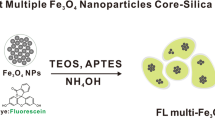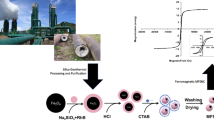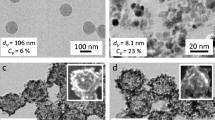Abstract
Dual functions of magnetic and fluorescent properties were created in composite particles that incorporated magnetite (Fe3O4) nanoparticles in particle cores of silica and fluorescent pyrene in particle shells of polystyrene. The Fe3O4 nanoparticles were prepared with a conventional homogeneous precipitation method and surface modified with a coupling agent of carboxyethylsilanetriol. The silica particles incorporating Fe3O4 nanoparticles were synthesized with a modified Stöber method in which the Fe3O4 nanoparticles were added to a system of tetraethylorthosilicate (TEOS)/ammonia/water/ethanol. Then, the magnetite/silica composite particles were coated with the pyrene/polystyrene shell in a soap-free emulsion polymerization, which was conducted in the presence of pyrene in a mixed solvent of water/ethanol. The composite particles prepared in the mixed solvent had both magnetic and fluorescent properties. The fluorescent spectrum of the particles with Fe3O4 was very similar to that without Fe3O4, indicating that the magnetic component within the core particles scarcely interfered with the fluorescent emission from the polymer shell.
Similar content being viewed by others
Explore related subjects
Discover the latest articles, news and stories from top researchers in related subjects.Avoid common mistakes on your manuscript.
Introduction
Composite microspheres with dual functions of magnetic and fluorescent properties have recently received much attention in various fields such as cell labeling [1], biosensing [2], and in the drug delivery system [3, 4]. Several methods have been developed for preparing the composite microspheres [5–11]. Mandal et al. [5] prepared oil droplets containing both magnetic iron oxide particles and fluorescent semiconductor quantum dots and showed that the intensity of the droplet fluorescence decreased with an increase in magnetic nanoparticle concentration. The intensity decrease was explained to be caused by the magnetic absorption of the fluorescence.
Recently, Salgueiriño-Maceira et al. [6] synthesized composite particles with a magnetic core and a fluorescent shell. This type of core–shell structures may be useful for avoiding the absorption of fluorescence by magnetic components, since the magnetic and fluorescent components can be confined to core and shell parts, respectively. Their synthesis employed a modified Stöber method combined with a layer-by-layer (LbL) assembly technique. The modified Stöber method involved controlled addition of tetraethyl orthosilicate to a dispersion of Fe3O4/γ-Fe2O3 nanoparticles, which were homogeneously incorporated as cores into monodisperse silica particles. After the LbL assembly on the silica-coated Fe3O4/γ-Fe2O3 particles, CdTe quantum dots were deposited onto the surfaces of the silica-coated particles, which were finally covered with an outer shell of silica.
An important factor of composite particles for their application is the surface properties of the particles. The present work proposes an alternative method for synthesizing the dually functional particles, which have a core–shell structure different from those reported by previous researchers [7–11]. The particles in this work consist of an inner part of silica multicored with Fe3O4 nanoparticles and a hybrid shell of polymer and organic dye. A basic technique of this work is polymer coating on silica particles.
We have developed a soap-free emulsion polymerization technique for polymer coating on oxide core particles. Various types of composite particles such as polystyrene (PSt)-coated silica particles with low polydispersity [12], multilayered gold–silica–PSt core–shell particles [13], and jingle bell-shaped hollow spheres [14] could be prepared with the coating technique. Such polymer shells provide a high affinity for other organic molecules, which is often important for bio-separation applications. In addition, this high affinity facilitates incorporation of fluorescent, organic dyes into polymer particles during polymerization [15, 16]. In the present work, the formation of fluorescent polymer shells on magnetic silica cores is tested to fabricate composite particles with the dual functions. Soap-free emulsion polymerization in the presence of the magnetic cores and a fluorescent dye is performed to form the fluorescent polymer shell.
Experimental
Materials
Iron (III) chloride (FeCl3), ammonia (NH3, 25%), tetraethyl orthosilicate (TEOS, 95%), styrene (99%), potassium persulfate (KPS, 98%), sodium p-styrenesulfonate (NaSS), and pyrene were obtained from Wako Pure Chemical Industries (Osaka, Japan) and used as received. Iron (II) chloride (FeCl2, Superpurification Science Laboratory, Saitama, Japan), 3-methacryoxypropyltrimethoxysilane (MPTMS, 95%, Shinetsu Chemicals, Tokyo, Japan), and carboxyethylsilanetriol sodium salt (NaOSi(OH)2CH2CH2COONa, 25% in water, Gelest) were used without further purification. Styrene was distilled at a reduced pressure under a nitrogen atmosphere. Water was deionized and distilled to have an electric resistance higher than 18 MΩ cm.
Preparation of magnetic silica particles
Aqueous dispersion of magnetic nanoparticles was prepared according to the Massart method [17]. An aqueous solution of 5 cm3 containing HCl and FeCl2 at an equal concentration of 2 M was mixed with 20 cm3 of FeCl3 aqueous solution at 1 M. Then, this mixture was dissolved into 250 cm3 of NH3 aqueous solution at 0.7 M and stirred for 1 h to complete the reaction. Black precipitates formed in the reaction were separated with a magnet placed under the vessel of the solution. The precipitates were washed by addition of the water and centrifugal separation. After removal of the supernatant, the water was added to the residual particles to prepare the suspension with a volume of 275 cm3.
The magnetic particles in the suspension were surface modified with a coupling agent of carboxyethylsilanetriol. First, the magnetic particle suspension was deoxidized with N2 bubbling for 30 min under stirring at 300 rpm. To well disperse the magnetic particles, sonication was irradiated to the suspension in the last 15 min of the deoxidization. After heating the suspension up to 70 °C, 5.4 cm3 of the coupling agent was added to the 275-cm3 suspension. The suspension of magnetic particles was stirred for 1 h at the same temperature. Then, the solvent of the suspension was replaced with ethanol by centrifugal treatment. The concentration of magnetic particles in the suspension was measured with inductively coupled plasma atomic emission spectroscopy (Seiko Instruments, SPS7800) and adjusted to 1,000 ppm (Fe weight).
Ammonia-catalyzed TEOS hydrolysis in a mixed solvent of water and ethanol was applied to the preparation of magnetic silica particles. The suspension (10 cm3) of surface-modified magnetic nanoparticles was added to the system (290 cm3) after the initiation of TEOS hydrolysis and stirred for 4 h to complete the reaction at 30 °C. The concentrations of TEOS, H2O, and NH3 in the reaction were 0.2, 5, and 1 M, respectively. Finally, the magnetic silica particles were surface modified with a coupling agent of MPTMS to introduce methacryl groups onto which PSt can graft in polymerization for the polymer shell formation.
Fabrication of the fluorescent polymer shell onto the core particles
The fabrication of the fluorescent polymer shell was performed in a batch reactor (1,000 cm3) equipped with a six-bladed 45°-pitched paddle impeller with a diameter of 6 cm. The fabrication was mainly performed by the following procedure. An aqueous solution of KPS and NaSS was mixed with the suspension of the MPTMS-modified silica particles in the batch reactor. The mixture was heated up to 70 °C, and styrene monomer dissolving a fluorescent dye, pyrene, was added to the mixture under stirring at a rate of 300 rpm. The stirring was continued for 8 h in the reaction.
Characterization
Transmission electron microscopy (TEM, Zeiss, LEO 912 OMEGA) was used to observe the composite particles. More than 200 diameters were measured for each distribution and used to calculate volume-averaged diameter, d V, and coefficient of variation, C V .
A vibrating-sample magnetometer (VSM-5–15, Toei, Japan) was used at room temperature to measure the magnetic properties of Fe3O4 and magnetic composite particles.
Fluorescent spectra were measured with excitation light of 338 nm in a Hitachi F-4500 fluorophotometer. Before the measurement, the composite particles were washed twice with centrifuging processes, and the suspension of composite particles was diluted 1,000-fold.
Results and discussion
Preparation of core particles
Figure 1 shows a TEM image of Fe3O4–silica composite particles, which were prepared in the TEOS hydrolysis with the addition of Fe3O4 nanoparticles at a reaction time of 2 min. The addition time was determined in our previous work where the addition time was varied from 0 to 10 min. [18]. The addition time was chosen to obtain colloidally stable and highly monodisperse composite particles. Although the presence of Fe3O4 nanoparticles was not clearly observed in the TEM image, the composite particles had a saturation magnetization of 0.44 emu/g. The d V and C V of the composite particles were 330 nm and 10.9%, respectively.
Prior to coating experiments where the Fe3O4–silica composite particles were used as the cores, Fe3O4-free silica particles were used to select reaction conditions suitable for the polymer shell formation. For this purpose, silica particles that had the same average size as the composite particles in Fig. 1 were prepared from the TEOS hydrolysis. The silica particles had a C V value of 6.2%. Figure 2 presents a TEM image of the silica particles, which were used in coating experiments in the following section.
Formation of the polymer shell onto the silica core particles
Table 1 shows polymerization conditions to form the fluorescent polymer shell. In the polymerizations of run nos. 1–4, Fe3O4-free silica particles were used as cores. Figure 3a shows a TEM image of particles formed in the polymerization of no. 1 where a mixed solvent of water/ethanol was used. The solvent composition was the same as that for the preparation of the Fe3O4-free particles. Polydisperse polymer particles sticking to each other were formed in Fig. 3a, and it is difficult to confirm that all the polymer particles contained the core particles. The polydispersity might be caused by aggregation of the core particles in the mixed solvent of water and ethanol.
An increase in the dielectric constant of solvent is an effective way to increase electrostatic repulsion between particles [19]. In run no. 2, water was used as a solvent with a high dielectric constant. The particles formed in this experiment are shown in the TEM image of Fig. 3b, which indicates the generation of a number of spherical polymer particles smaller than the core particles. Strong electrostatic interaction in water due to the high dielectric constant might repel ionic polymer species from the core particles.
In run no. 3, polymerization was performed with the same mixed solvent as run no. 1 at a low concentration of the styrene monomer because a decrease in organic component with a low dielectric constant is expected to enhance the electrostatic interaction between composite particles. The TEM image in Fig. 3c shows an improvement in the monodispersity of composite particles, indicating that silica particles at the low concentration (run no. 3) were more uniformly covered with the polymer. However, it appeared that some aggregation occurred between the particles.
In the polymerization of run no. 4, the concentration of core particles was lowered to one fourth of run no. 3. According to the change in particle concentration, the concentrations of KPS, NaSS, and MPTMS were lowered to the same degree. In the TEM image of Fig. 3d, particle aggregation was scarcely observed. The decrease in the number of particles might reduce the particle aggregation, which might further reduce through a decrease in ionic strength caused by the reagent concentration changes. The d V of the core–shell particles in the polymerization was 566 nm, and the C V of the core–shell particles was 6.7% close to that of the core particles in Fig. 2.
Formation of the polymer shell onto the magnetic core particles
Figure 4 shows the TEM image of core–shell particles obtained in the polymerization listed in run no. 5. The formation of the polymer shell was performed in the presence of the magnetic silica particles at the same agent concentrations as in run no. 4. The magnetic silica particles in Fig. 4 were slightly eccentric inside composite particles. Ge et al. [20] mentioned that the formation of such eccentric structure is due to the interfacial tension between the hydrophilic core particle and the hydrophobic monomer. In the present experiment, dissolving pyrene into the monomer might render monomer phase more hydrophobic, resulting in the eccentric structure in the composite particles. The d V of the core–shell particles was 502 nm similar to that in run no. 4. The thickness of the polymer shell was almost consistent with the one calculated from the core particles and the monomer added to the reaction system. The C V of the core–shell particles was 10.8% close to that of the magnetic silica particles.
Properties of magnetism and fluorescence
Figure 5 presents the magnetization curves of the core–shell particles obtained in run no. 5, where the weight ratio of Fe3O4 particles to the core–shell particles was 0.23 wt%. The core–shell particles exhibited superparamagnetic properties: No remnant magnetism was observed when the magnetic field was removed. Saturation magnetization of the particles was 0.14 emu/g comparable to the one calculated from the Fe3O4 weight fraction and the saturation magnetization of Fe3O4 (51.7 emu/g).
Figure 6 shows fluorescent spectra of Fe3O4-free core–shell particles and magnetic core–shell particles, which were synthesized in the conditions of run nos. 4 and 5, respectively. Main peaks at 385 nm in both spectra can be attributed to intrinsic peaks (I 3) of pyrene molecules. The spectrum of the magnetic core–shell particles was very similar to that of Fe3O4-free core–shell particles. The similarity revealed that the magnetic component within core particles scarcely interfered with fluorescent emission from the polymer shell.
Preparations of the composite particles with magnetic and fluorescent properties were also carried out at high pyrene concentrations of 5.0 and 10 × 10−3 mol/L polymer in run nos. 6 and 7. Fluorescent spectra of the composite particles are compared in Fig. 7 with the spectrum obtained for the pyrene concentration of 1.0 × 10−3 mol/L polymer in run no. 5. An increase in pyrene concentration in the polymerization raised the intensity of fluorescence. Three intrinsic peaks of 375 (I 1), 385 (I 3), and 394 nm for pyrene molecules were clearly observed for the pyrene high concentrations. It is reported that intensity ratios of I 1/I 3 depend on the dielectric constant of the disperse medium surrounding the pyrene molecules [21]. The intensity ratios for the pyrene concentrations of 1.0, 5.0, and 10 × 10−3 mol/L polymer were 0.76, 0.85, and 0.9, respectively, which are close to the specific value of 0.95 reported for pyrene incorporated into PSt and clearly different from the value of 1.9 reported for pyrene in water. Based on fluorescent spectra of the mixed solvent after polymerization, estimated concentrations of pyrene incorporated into the polymer shell were in a range of 0.37–2.2 × 10−3 mol/L polymer. Although percentages of the weights of pyrene incorporated into the polymer shells were in a range of 20–40%, the pyrene concentration in the polymer shell could be raised with the amount of pyrene added.
Conclusion
Composite particles with a magnetic silica core and a fluorescent polymer shell could be prepared with a combination of a modified Stöber method and soap-free polymerization in the presence of pyrene. The C V value of the composite particles was 10.8% close to the criterion for monodispersed particles. The comparison of fluorescent spectra for the composite particles with and without magnetic component revealed that the magnetic component within core particles scarcely interfered with fluorescent emission from the polymer shell. The concentration of pyrene in the polymer shells could be raised to 2.2 × 10−3 mol/L polymer with the amount of pyrene added to the polymerization system.
References
Vuu K, Xie J, McDonald MA, Bernardo M, Hunter F, Zhang Y, Li K, Bednarski M, Guccione S (2005) Bioconjug Chem 16:995
Dubus S, Gravel J-F, Drogoff BL, Nobert P, Veres T, Boudreau D (2006) Anal Chem 78:4457
Holzapfel V, Lorenz M, Weiss CK, Schrezenmeier H, Landfester K, Mailänder V (2006) J Phys Condens Matter 18:S2581
Guo J, Yang W, Wang C, He J, Chen J (2006) Chem Mater 18:5554
Mandal SK, Lequeux N, Rotenberg B, Tramier M, Fattaccioli J, Bibette J, Dubertret B (2005) Langmuir 21:4175
Salgueiriño-Maceira V, Correa-Duarte MA, Spasova M, Liz-Marzán LM, Farle M (2006) Adv Funct Mater 16:509
Zhang L, Liu B, Dong S (2007) J Phys Chem B 111:10448
Sathe TR, Agrawal A, Nie S (2006) Anal Chem 78:5627
Lin Y-S, Wu S-H, Hung Y, Chou Y-H, Chang C, Lin M-L, Tsai C-P, Mou C-Y (2006) Chem Mater 18:5170
Wilson R, Spiller DG, Prior IA, Bhattd R, Hutchinson A (2007) J Mater Chem 17:4400–4406 DOI 10.1039/b708174j
Yu S-Y, Zhang H-J, Yu J-B, Wang C, Sun L-N, Shi W-D (2007) Langmuir 23:7836
Gu S, Kondo T, Konno M (2004) J Colloid Interface Sci 272:314
Gu S, Onishi J, Mine E, Kobayashi Y, Konno M (2004) J Colloid Interface Sci 279:284
Gu S, Kondo T, Mine E, Nagao D, Kobayashi Y, Konno M (2004) J Colloid Interface Sci 279:281
Nagao D, Anzai N, Kobayashi Y, Gu S, Konno M (2006) J Colloid Interface Sci 298:232
Gu S, Anzai N, Nagao D, Kobayashi Y, Konno M (2005) e-Polymers 64:1
Massart R (1981) IEEE Trans Magn MAG-17:1247
Kobayashi Y, Saeki S, Yoshida M, Nagao D, Konno M (2008) J Sol-Gel Sci Technol 45:35–41
Mine E, Nagao D, Kobayashi Y, Konno M (2005) J Sol-Gel Sci Technol 35:197
Ge J, Hu Y, Zhang T, Yin Y (2007) J Am Chem Soc 129:8974
Wilhelm M, Zhao C-L, Wang Y, Xu R, Winnik MA, Mura J-L, Riess G, Croucher MD (1991) Macromolecules 24:1033
Acknowledgment
This research was partially supported by a Grant-in-Aid for Science Research (no. 17760551) and by the COE project, Giant Molecules and Complex Systems from the Ministry of Education, Culture, Sports, Science, and Technology of Japan.
Author information
Authors and Affiliations
Corresponding author
Rights and permissions
About this article
Cite this article
Nagao, D., Yokoyama, M., Saeki, S. et al. Preparation of composite particles with magnetic silica core and fluorescent polymer shell. Colloid Polym Sci 286, 959–964 (2008). https://doi.org/10.1007/s00396-008-1855-5
Received:
Revised:
Accepted:
Published:
Issue Date:
DOI: https://doi.org/10.1007/s00396-008-1855-5











